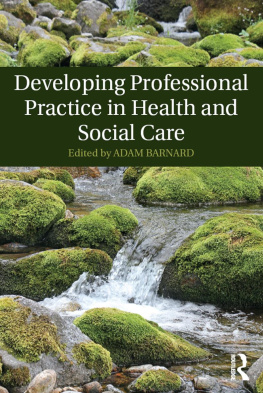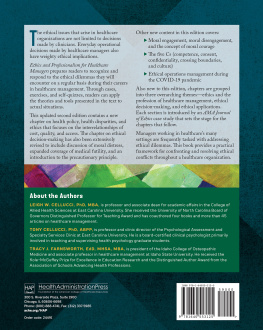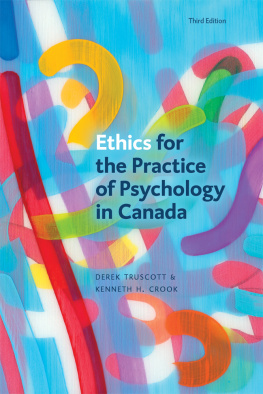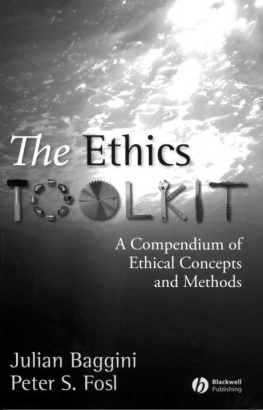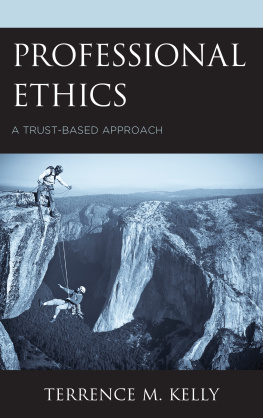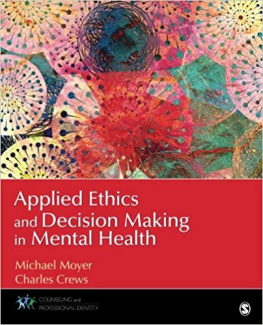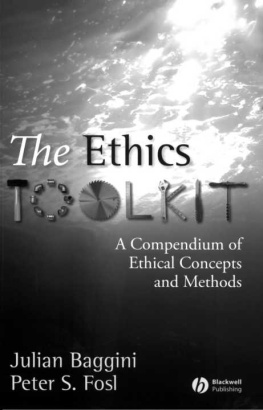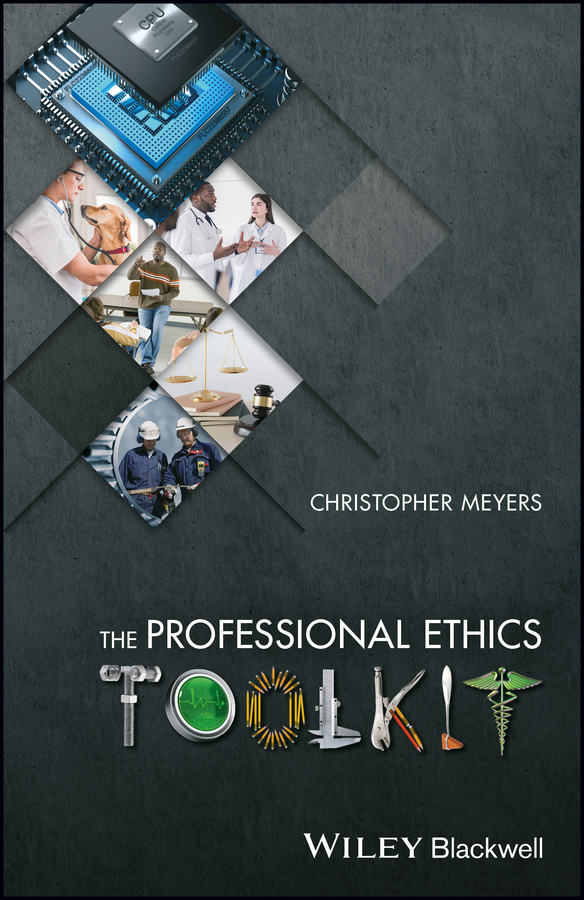
Table of Contents
Guide
Pages
CHRISTOPHER MEYERS
THE PROFESSIONAL ETHICS TOOLKIT
This edition first published 2018
2018 John Wiley & Sons Ltd
All rights reserved. No part of this publication may be reproduced, stored in a retrieval system, or transmitted, in any form or by any means, electronic, mechanical, photocopying, recording or otherwise, except as permitted by law. Advice on how to obtain permission to reuse material from this titleis available at http://www.wiley.com/go/permissions.
The right of Christopher Meyers to be identified as the author of this work has been asserted in accordance with law.
Registered Office
John Wiley & Sons, Inc., 111 River Street, Hoboken, NJ 07030, USA
John Wiley & Sons Ltd, The Atrium, Southern Gate, Chichester, West Sussex, PO19 8SQ, UK
Editorial Office
9600 Garsington Road, Oxford, OX4 2DQ, UK
For details of our global editorial offices, customer services, and more information about Wiley products visit us at www.wiley.com.
Wiley also publishes its books in a variety of electronic formats and by printondemand. Some content that appears in standard print versions of this book may not be available in other formats.
Limit of Liability/Disclaimer of Warranty
While the publisher and authors have used their best efforts in preparing this work, they make no representations or warranties with respect to the accuracy or completeness of the contents of this work and specifically disclaim all warranties, including without limitation any implied warranties of merchantability or fitness for a particular purpose. No warranty may be created or extended by sales representatives, written sales materials or promotional statements for this work. The fact that an organization, website, or product is referred to in this work as a citation and/or potential source of further information does not mean that the publisher and authors endorse the information or services the organization, website, or product may provide or recommendations it may make. This work is sold with the understanding that the publisher is not engaged in rendering professional services. The advice and strategies contained herein may not be suitable for your situation. You should consult with a specialist where appropriate. Further, readers should be aware that websites listed in this work may have changed or disappeared between when this work was written and when it is read. Neither the publisher nor authors shall be liable for any loss of profit or any other commercial damages, including but not limited to special, incidental, consequential, or other damages.
Library of Congress CataloginginPublication Data
Names: Meyers, Christopher, 1957 author.
Title: The professional ethics toolkit / by Christopher Meyers.
Description: First edition. | Hoboken, NJ, USA : John Wiley & Sons Ltd, 2018. | Includes bibliographical references and index.
Identifiers: LCCN 2017047294 (print) | LCCN 2017052284 (ebook) | ISBN 9781119045175 (pdf) | ISBN 9781119045182 (epub) | ISBN 9781119045168 (cloth) | ISBN 9781119045151 (pbk.)
Subjects: LCSH: Professional ethics.
Classification: LCC BJ1725 (ebook) | LCC BJ1725 .M49 2018 (print) | DDC 174dc23
LC record available at https://lccn.loc.gov/2017047294
Cover Images: (Background) Tashatuvango/Shutterstock; (Microchip) Iaroslav Neliubov/Shutterstock; (Veterinarian) Zivica Kerkez/Shutterstock; (Doctors) Olena Yakobchuk/Shutterstock; (Professor) sirtravelalot/Shutterstock; (Gavel and scale) one photo/Shutterstock; (Workers) Christian Lagerek/Shutterstock; (Toolkit images) Winston Link/Shutterstock; pictafolio/Gettyimages; ProstoVova/Gettyimages; Science Photo Library/Shutterstock; Thomas Northcut/Gettyimages; Keith Bell/Shutterstock; jgroup/Gettyimages
Cover Design: Wiley
To my family, in gratitude for the inspiration and joy you provide every single day.
Acknowledgments
I am indebted to the many students and working professionals who have, over the years, helped me to explore and better understand the issues discussed in this book. I also am thankful to colleagues for serving as a sounding board for ideas. And I am especially grateful to Hugh LaFollette, whose encouragement and good editing were instrumental to my engagement with professional ethics.
Introduction
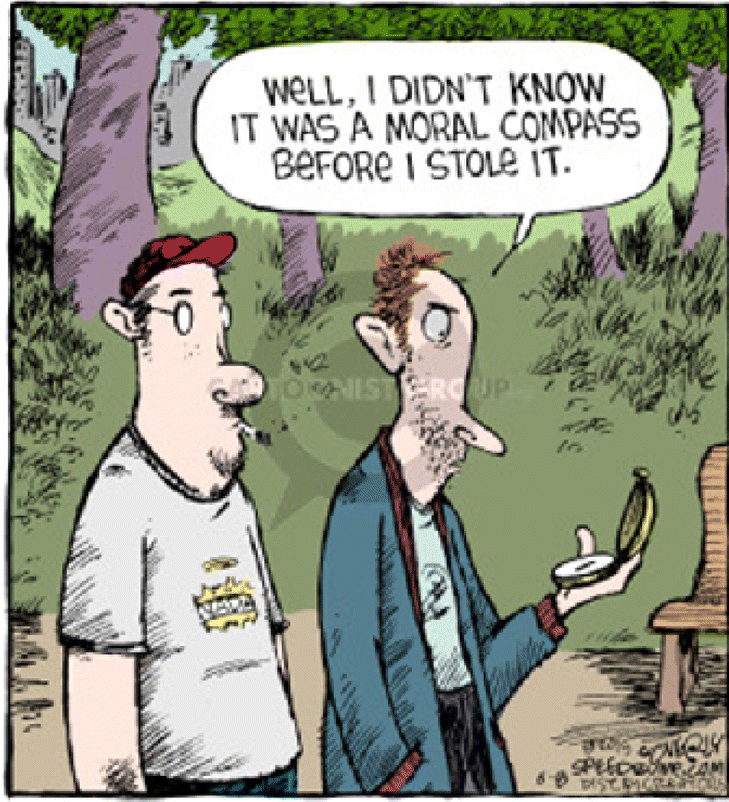
Opening Thoughts
I was recently enjoying lunch with a couple of highranking police officers when the following exchange took place:
OFFICER ONE :
What are you working on these days, Christopher?
ME :
A book on professional ethics.
OFFICER TWO (laughing out loud):
Oh, as opposed to amateur ethics? Im really good at those!
OFFICER ONE :
Heck, Im just trying to be better than a novice at ethics havent quite made it to amateur status.
OFFICER TWO :
Is there someone I can pay to be an ethics professional?
Good chuckles ensued all around, but their clever play on words captured a key problem with the topic of this book just what do we mean by professional ethics? Consider the following statements, all of which rely on a different meaning of the term:
- Muhammad Ali became a professional boxer in, after fighting for six years as an amateur.
- That painter sure did a professional job, dont you think?
- Prostitution is the worlds oldest profession.
- You can count on Jones gardening: we are the most professional in town.
- Sam sure is a professional complainer.
- Did you hear Gabriela passed her licensing exam and is now a professional engineer?
You probably recognize each of the different senses and have probably used several yourself. Despite some clear overlap, the meanings attached to the different uses vary so much that no single ethics conversation could effectively apply to all the specific ethical duties attached to professional boxing, for example, differ widely from those of engineering.
This book focuses on the last meaning, that is, on the formalized sense of professional. It does so for two reasons. First, the other meanings all derive from the last in that they appeal to some version of a higher standard, one worthy of additional pay or respect. Even the fifth usage gets at the idea that Sam is a really good complainer. That is, they are at least loosely tapping into the common understanding that to be a professional is to possess a normative commitment to higher quality.
Second, the very goal of this book is to make explicit that normativity, the moral foundation at the core of professionalism. In short (for now), the thesis of this book is that to be a true professional, unlike other economic activities, is to be dedicated to a client relationship grounded in trust: trust in the professionals competence and in her commitment to place the wellbeing of her client at the forefront of their encounters.
Think of it this way:
Youre in the market for a new car so you go to a local dealership, settle on a model, and, after some haggling, agree on a price. Thrilled with your shiny new toy, you happen to run into your buddy Omar a few days later who, lo and behold, has just bought the same model! In discussing the options you each purchased, Omar says, I guess you didnt read the Consumer Reports review. You agree that you didnt and he goes on to explain that they concluded this model doesnt need such addons as rust coating, an extended warranted, or sealcoat paint all items that you now realize you got suckered into buying by the very persuasive salesman. You also learn, to your great annoyance, that Omar also paid considerably less for his, even taking into account those addons.
Next page

